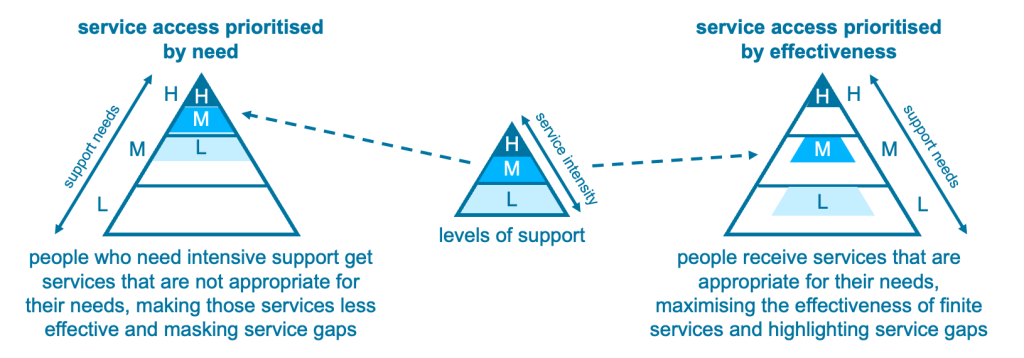The services people need from publicly funded organisations vary by type and intensity. Services designed for people who need less intensive support tend not to work well for people who need more support. When there are not enough intensive services available for the people who need them, it’s tempting to offer whatever is available, even if it cannot meet their needs. Giving targeted services to the wrong cohort risks missing the point entirely.
Workers in publicly funded organisations generally want to help people. Particularly for the people who are most in need of support, most workers will try to help in whatever way they can.
Higher intensity services tend to cost more to deliver and may need to be sustained longer to be effective. There are often not enough resources to support everyone who needs intensive services.
Workers tend to prioritise access to whatever services are available based on who most needs support. They may believe that any support is better than nothing, or may not trust that appropriate support will be available elsewhere. When workers offer services that miss the mark, many people with intensive support needs get services that were never designed for their needs.
Services designed to help a specific cohort may be entirely ineffective for people with different needs. For example, early interventions designed to help at-risk populations avoid harm are unlikely to help someone who has been harmed and needs help to recover.
Making good services less effective by giving them to the wrong cohort makes resource constraints worse. Resources that could have genuinely helped people who need less intensive support are wasted, while failing people who needed more. Misdirected early interventions cannot prevent future harm, and fail to reduce future demand for intensive support to recover.
This is also frustrating for well-intentioned service providers. Workers can be demotivated when their work is ineffective, no matter how hard they try.

Maximising the value of all available services starts with understanding where they fit on the spectrum of supports and people who need them. General services are designed to meet a wide range of needs. Targeted services are designed, and effective, for specific cohorts. Provide targeted supports only to people who are likely to gain the intended benefits; refer everyone else to more appropriate services.
Even when services are targeted well, it is likely there will be unmet need across the system. But the gap will be smaller if all available services hit their targets, with better visibility of need and demand for different types and intensity of support. It will be easier to identify any surplus of a targeted service, and to divert some of its resources to services with unmet need, improving resource allocation over time.
Service systems work best when targeted supports go to the people who will benefit most, rather than to the people who are most in need of a different type of support. Sometimes, that means referring people who are suffering to a waiting list, rather than providing supports that will be inadequate for their needs but could help someone else. This takes discipline, and trust, from workers who show up to help people.
Workers who understand and trust their roles in a broader ecosystem can maximise the value of every service, helping people more overall. Workers focused on delivering the right services to the right people will also see benefits for more of the people they serve.
Better visibility can also improve resource allocation decisions, shifting from hit or miss services to targeted services that stay true to their aims.
